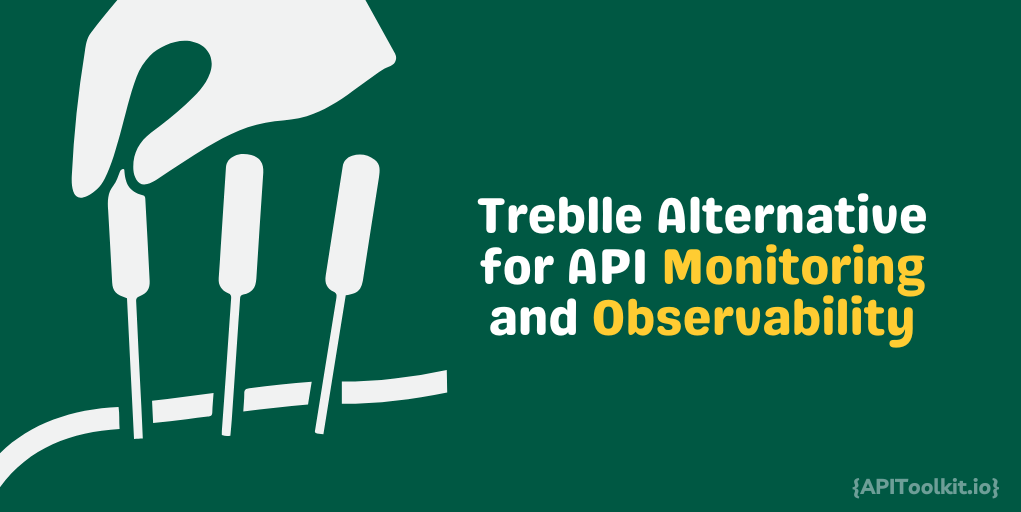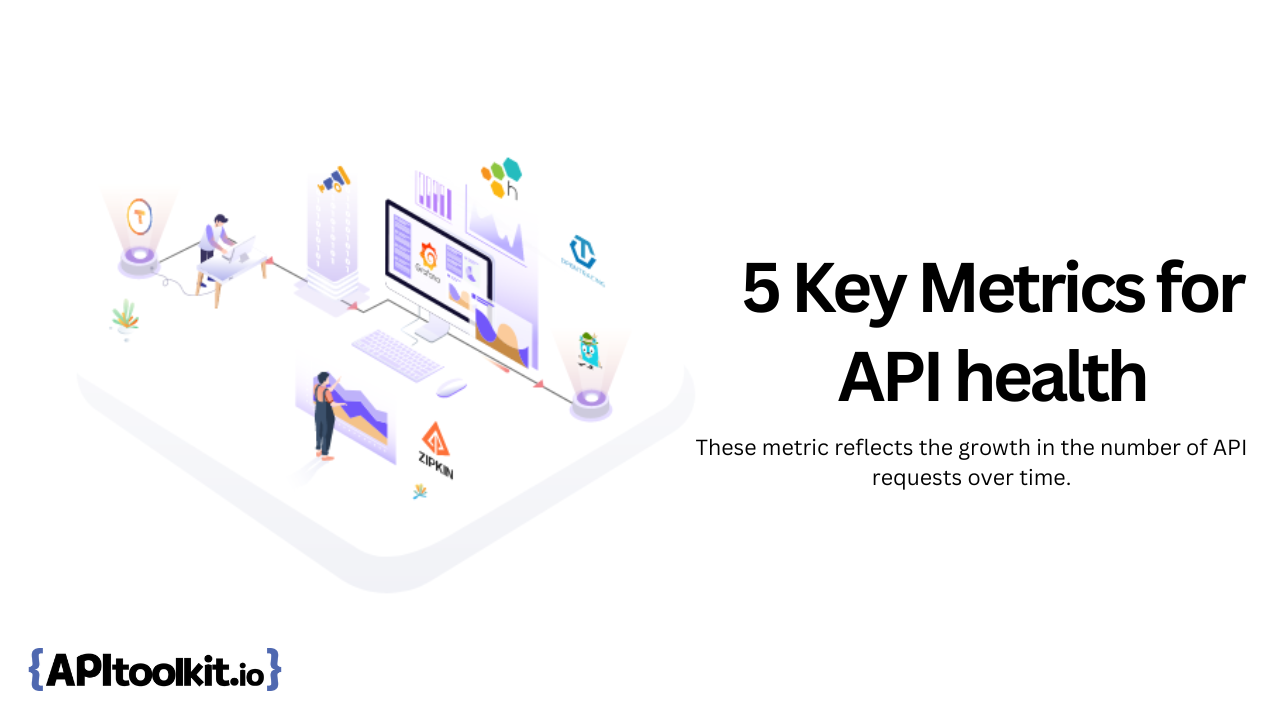APIToolkit: Treblle Alternative for API Monitoring and Observability

Few years back monitoring an API meant just watching server logs and making sure it was running. Back then, APIs were simpler, and we only needed to know if they were up or down. But as our digital world grew and APIs became more complex, linking many services and applications, we saw that the old ways of monitoring weren’t enough. That’s where advanced observability comes in. It’s not just about checking if an API works; it gives us deep insights into its performance. This new approach to monitoring lets us see everything about our APIs, using detailed analytics, processing data in real time, and even predicting future issues.
The Rising Importance of API Monitoring in Modern Software Development
Today, API monitoring is a critical component of any software development and operational strategy. In our interconnected world, APIs act as the glue that binds different parts of an application together, and their performance can make or break a business. With the rise of microservices architectures, cloud-native technologies, and a focus on user experience, the need for robust, reliable, and responsive APIs has never been greater. Effective API monitoring, therefore, is not just about avoiding downtime; it’s about optimizing performance, ensuring security, and delivering a seamless user experience. This heightened importance of API monitoring is a testament to its evolving role, from a back-end operational tool to a front-and-center strategic asset in modern software development.
Treblle: Setting the Standard in API Monitoring
When you are talking about API monitoring, Treblle has carved a significant niche for itself. This section delves into the features and capabilities of Treblle, analyzing its impact on contemporary API monitoring practices.
Overview of Treblle’s Features and Capabilities
Treblle offers a comprehensive suite of tools that make API monitoring not just easier but more insightful. Some of its standout features include:
- Real-Time Monitoring: Treblle provides real-time insights into API performance, allowing developers to track request and response times, error rates, and more.
- Automated Documentation: It generates up-to-date API documentation, ensuring that the API’s contract is always current and accessible.
- Error Detection and Reporting: Treblle excels in identifying and reporting errors, with detailed information that helps in quick debugging and resolution.
- User Behavior Analysis: Understanding how users interact with APIs is crucial, and Treblle offers analytics that highlight usage patterns and potential bottlenecks.
These features collectively contribute to a robust API monitoring experience, ensuring that APIs deliver optimal performance and reliability.
Impact of Treblle on API Monitoring Practices
Treblle has significantly influenced how developers and companies approach API monitoring. Its impact can be seen in several ways:
- Enhanced Developer Productivity: With automatic documentation and real-time insights, developers spend less time on manual monitoring and more on innovation.
- Improved API Reliability: Treblle’s detailed error reporting leads to quicker fixes, directly enhancing the reliability and uptime of APIs.
- Data-Driven Decisions: The analytics provided by Treblle allow teams to make informed decisions about API modifications and improvements.
- User-Centric Development: Understanding user interactions with APIs helps in optimizing the end-user experience.
Treblle’s holistic approach to API monitoring has set a high standard in the industry, driving a shift towards more proactive and user-focused API management.
APIToolkit: A Comprehensive Alternative to Treblle
As the digital landscape evolves, so does the need for more advanced API monitoring solutions. APIToolkit emerges as a formidable alternative to Treblle, bringing a fresh perspective and enhanced capabilities to API monitoring and observability.
Introduction to APIToolkit’s Unique Approach
APIToolkit is designed with the modern developer in mind, offering a suite of features that go beyond traditional API monitoring. It’s not just about watching over your APIs; it’s about gaining deep insights and proactively improving your API ecosystem. Here’s what makes APIToolkit stand out:
- Intelligent Payload Analysis: Unlike traditional tools that focus on uptime and basic metrics, APIToolkit delves into the payload, understanding the structure and semantics of the data being exchanged.
- Automated OpenAPI Specification: APIToolkit can automatically generate and update OpenAPI specifications based on actual traffic, ensuring your documentation is always accurate and up-to-date.
- Real-Time Breaking Change Detection: It monitors your API traffic in real time and alerts you to any breaking changes, enabling you to address issues before they affect end-users.
- Automated End-to-End Testing: Leveraging the OpenAPI specifications, APIToolkit can automatically create and run end-to-end tests, ensuring comprehensive coverage of all user flows.
Comparative Analysis of APIToolkit and Treblle
While Treblle has set a high bar in API monitoring, APIToolkit brings unique features to the table that address specific pain points in API development and maintenance:
- Focus on API Payloads: APIToolkit’s ability to understand and analyze API payloads offers a level of insight that is invaluable for complex systems where the data structure and integrity are critical.
- Proactive Change Management: By detecting breaking changes in real-time, APIToolkit ensures that any modifications in the API structure are immediately known, reducing the risk of unintended disruptions.
- Enhanced Testing Automation: The automatic generation of end-to-end tests from OpenAPI specifications streamlines the testing process, ensuring that tests are always aligned with the current API implementation.
Key Differentiators: APIToolkit vs. Treblle
In the competitive landscape of API monitoring tools, APIToolkit and Treblle both offer compelling features, but APIToolkit stands out with its advanced capabilities and unique approach. Let’s delve into what sets APIToolkit apart from Treblle.
Advanced Features and Capabilities in APIToolkit
APIToolkit is designed to provide a comprehensive solution for API monitoring, with features that cater to the nuanced needs of modern software development:
- Deep Payload Inspection: APIToolkit’s ability to analyze the contents of API requests and responses in real-time provides unparalleled insights into the data your APIs are handling, ensuring data integrity and consistency.
- Automated OpenAPI Documentation: APIToolkit automatically generates and updates OpenAPI specifications based on observed traffic, keeping your API documentation in sync with its actual behavior, a feature that is vital for maintaining clear and accurate developer documentation.
- Real-Time Breaking Change Detection: It proactively monitors for and alerts on breaking changes in your API, allowing teams to respond immediately to potential issues before they impact users, thereby enhancing the stability and reliability of your API ecosystem.
- End-to-End Testing Automation: By using the generated OpenAPI specifications, APIToolkit automatically creates comprehensive end-to-end tests, ensuring that every aspect of your API is tested against real-world use cases, reducing the manual effort required for test maintenance.
How APIToolkit Enhances and Extends Beyond Treblle’s Functionality
While Treblle provides robust API monitoring capabilities, APIToolkit extends these functionalities with its proactive and automated features:
- Proactive vs. Reactive Monitoring: Unlike Treblle, which excels in real-time monitoring and error reporting, APIToolkit emphasizes proactive issue prevention by identifying potential problems before they affect users, shifting the focus from reactive troubleshooting to preventive care.
- Data-Driven Insights: APIToolkit’s emphasis on understanding API payloads offers deeper insights into API performance and usage patterns, allowing for more informed decision-making regarding API improvements and optimizations.
- Comprehensive Testing Coverage: The automatic generation of end-to-end tests by APIToolkit not only saves time but also ensures that tests cover the latest changes in your API, providing a safety net that adapts as your API evolves.
What Features Makes APIToolkit Unique
APIToolkit stands out in the world of API monitoring with its cutting-edge features designed to elevate the API lifecycle management to new heights. This section explores its core functionalities that differentiate it from other tools like Treblle.
Automated OpenAPI Specification and Breaking Change Detection
One of APIToolkit’s standout features is its automated OpenAPI specification generation. This innovative feature dynamically creates and updates OpenAPI specs based on live API traffic, ensuring that the documentation always reflects the current state of your APIs. This automation eliminates the manual upkeep traditionally associated with API documentation, significantly reducing the potential for human error and ensuring developers and stakeholders have access to accurate, up-to-date information.
-
How It Works: APIToolkit analyzes incoming and outgoing API requests and responses, intelligently constructing an OpenAPI specification that maps out the structure and expected behavior of your APIs.
-
Benefits: This automated process not only streamlines documentation workflows but also enhances collaboration across teams by providing a single source of truth for API contracts.
-
Real-World Application: Consider a scenario where a seemingly minor update to an API inadvertently changes the data type of a commonly used field. APIToolkit would detect this change immediately, alerting the development team before the altered response could impact dependent services or end-users.
Real-Time API Data Analysis and End-to-End Testing
APIToolkit goes beyond surface-level monitoring by offering in-depth analysis of API data in real-time. This capability allows teams to gain insights into the payload, uncovering patterns, anomalies, and potential optimizations that might not be evident through traditional monitoring methods.
- Data-Driven Insights: Beyond just monitoring if your API is up and running, APIToolkit dives into the data your API is sending and receiving. It looks for patterns, unexpected behavior, and opportunities for optimization. This isn’t just about spotting problems; it’s about understanding how your API is used in the real world. This insight can guide improvements, making your API faster, more reliable, or easier to use. It’s like having a magnifying glass over the data flow, giving you a clearer picture of your API’s performance and usage.
End-to-end (E2E) testing automation is another cornerstone of APIToolkit’s feature set. Leveraging the OpenAPI specifications it generates, APIToolkit can automatically create comprehensive E2E tests that simulate real user interactions, providing a thorough validation of the API’s functionality across different scenarios.
- Streamlined Testing Process: This automated approach to E2E testing ensures that as APIs evolve, the tests remain synchronized with the current API behavior, covering new and altered endpoints without manual intervention, thus maintaining a robust safety net for API reliability.
Integrating APIToolkit into your development workflow can transform your API monitoring and observability practices. Click here to get started with APIToolkit
Conclusion
As we’ve journeyed through the intricacies and innovations of APIToolkit, it’s evident that this platform offers a unique blend of advanced features and capabilities that set it apart in the domain of API monitoring and observability. Choosing APIToolkit over Treblle presents a strategic advantage for teams and organizations aiming to elevate their API lifecycle management to new levels of efficiency and effectiveness.
APIToolkit’s deep payload inspection, automated OpenAPI specification generation, real-time breaking change detection, and end-to-end testing automation collectively provide a comprehensive suite of tools that not only monitor but also proactively improve API health and performance. These features empower developers to focus on innovation and development rather than being bogged down by the manual overhead of monitoring and testing.
The integration of APIToolkit into your development workflow seamlessly bridges the gap between development and operations, fostering a DevOps culture that emphasizes collaboration, automation, and continuous improvement. Its ability to generate actionable insights from real-time API data analysis facilitates informed decision-making, ensuring that APIs are not only functional but also optimized for performance and user experience.
In conclusion, while Treblle has laid a strong foundation in API monitoring, APIToolkit builds upon and extends this foundation, offering a more nuanced, automated, and comprehensive approach to API observability. For teams striving to achieve excellence in their API-driven projects, APIToolkit presents a compelling choice, promising not just monitoring but a strategic partnership in driving API success.
Keep Reading
How to Generate Automated API Documentation
APIToolkit: Top Atatus Alternative for API Monitoring
API Documentation vs Specification: What It Means for You
How to Analyze API Logs and Metrics for Better Performance (Ultimate Guide)



